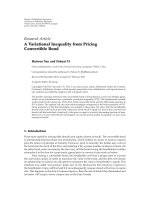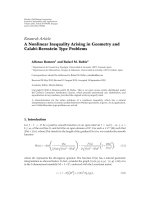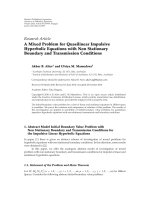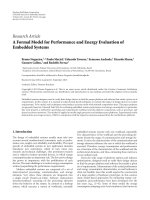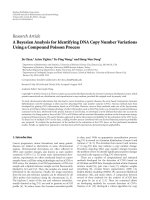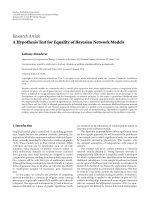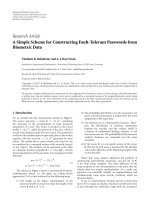Báo cáo hóa học: " Research Article A Cohen-Type Inequality for Jacobi-Sobolev Expansions" pptx
Bạn đang xem bản rút gọn của tài liệu. Xem và tải ngay bản đầy đủ của tài liệu tại đây (498.8 KB, 10 trang )
Hindawi Publishing Corporation
Journal of Inequalities and Applications
Volume 2007, Article ID 93815, 10 pages
doi:10.1155/2007/93815
Research Article
A Cohen-Type Inequality for Jacobi-Sobolev Expansions
Bujar Xh. Fejzullahu
Received 21 August 2007; Revised 20 November 2007; Accepted 11 December 2007
Recommended by Wing-Sum Cheung
Let μ be the Jacobi measure supported on the interval [
−1, 1]. Let us introduce the
Sobolev-type inner product
f ,g=
1
−1
f (x)g(x)dμ(x)+Mf(1)g(1) + Nf
(1)g
(1),
where M,N
≥ 0. In this paper we prove a Cohen-typ e inequality for the Fourier expan-
sion in terms of the orthonormal polynomials associated with the above Sobolev inner
product. We follow Dreseler and Soardi (1982) and Markett (1983) papers, w here such
inequalities were proved for classical orthogonal expansions.
Copyright © 2007 Bujar Xh. Fejzullahu. This is an open access article distributed under
the Creative Commons Attribution License, which permits unrestricted use, distribution,
and reproduction in any medium, provided the original work is properly cited.
1. Introduction and main result
Let dμ(x)
= (1 − x)
α
(1 +x)
β
dx, α>−1, β>−1, be the Jacobi measure supported on the
interval [
−1,1]. We will say that f (x) ∈ L
p
(dμ)if f (x)ismeasurableon[−1,1] and
f
L
p
(dμ)
< ∞,where
f
L
p
(dμ)
=
⎧
⎪
⎪
⎪
⎨
⎪
⎪
⎪
⎩
1
−1
f (x)
p
dμ(x)
1/p
if 1 ≤ p ≤∞,
ess sup
−1<x<1
f (x)
if p =∞.
(1.1)
Now let us introduce the Sobolev-type spaces
S
p
=
f : f
p
S
p
=f
p
L
p
(dμ)
+ M| f (1)
p
+ N
f
(1)
p
< ∞
,1≤ p<∞,
S
∞
=
f : f
S
∞
=f
L
∞
(dμ)
< ∞
, p =∞.
(1.2)
2 Journal of Inequalities and Applications
Let f and g function in S
2
. We can int roduce the discrete Sobolev-type inner product
f ,g=
1
−1
f (x)g(x)dμ(x)+Mf(1)g(1) + Nf
(1)g
(1), (1.3)
where M
≥ 0, N ≥ 0. We denote by {q
(α,β)
n
}
n≥0
the sequence of orthonormal polynomials
with respect to the inner product (1.3) (see [1, 2]). These polynomials are known in
the literature as Jacobi-Sobolev-type polynomials. For M
= N = 0, the classical Jacobi
orthonormal polynomials appear. We will denote them by
{p
(α,β)
n
}
n≥0
.
For f
∈ S
1
, the Fourier expansion in terms of Jacobi-Sobolev-typ e polynomials is
∞
k=0
f (k)q
(α,β)
k
(x), (1.4)
where
f (k) =
f ,q
(α,β)
k
. (1.5)
The Ces
`
aro means of order δ of the Fourier expansion (1.4) are defined by (see [3,
pages 76-77])
σ
δ
n
f (x) =
n
k=0
A
δ
n
−k
A
δ
n
f (k)q
(α,β)
k
(x), (1.6)
where A
δ
k
= (
k+δ
k
).
For a function f
∈ S
p
and a given sequence {c
k,n
}
n
k
=0
,n ∈ N ∪{0}, of complex num-
bers with
|c
n,n
| > 0, we define the operators T
α,β,M,N
n
by
T
α,β,M,N
n
( f ) =
n
k=0
c
k,n
f (k)q
(α,β)
k
. (1.7)
Let us denote p
0
= (4β +4)/(2β +3)anditsconjugateq
0
= (4β +4)/(2β +1). Here is
the main result.
Theorem 1.1. Let β
≥ α ≥−1/2, β>−1/2,and1 ≤ p ≤∞. There exists a positive constant
c, independent of n, such that
T
α,β,M,N
n
[S
p
]
≥ c|c
n,n
|
⎧
⎪
⎪
⎪
⎨
⎪
⎪
⎪
⎩
n
(2β+2)/p−(2β+3)/2
if 1 ≤ p<p
0
,
(log n)
(2β+1)/(4β+4)
if p = p
0
, p = q
0
,
n
(2β+1)/2−(2β+2)/p
if q
0
≤ p<∞,
(1.8)
where by [S
p
] one denotes the space of all bounded, linear ope rators from the space S
p
into
itself, with the usual operator norm
·
[S
p
]
.
Bujar Xh. Fejzullahu 3
Corollar y 1.2. Let α, β,andp be as in Theorem 1.1.Forc
k,n
= 1, k = 0, , n, and for p
outside the Pollard interval (p
0
,q
0
),
S
n
[S
p
]
−→ ∞ , n −→ ∞ , (1.9)
where S
n
denotes the nth partial sum of the expansion (1.4).
For c
k,n
= A
ρ
n
−k
/A
ρ
n
,0≤ k ≤ n, Theorem 1.1 yields the following.
Corollar y 1.3. Let α, β, p,andδ be given numbers such that β>
−1/2,
−
1
2
≤ α ≤ β,
1
≤ p ≤∞,
0
≤ δ<
2β +2
p
−
2β +3
2
if 1
≤ p<p
0
,
0
≤ δ<
2β +1
2
−
2β +2
p
if q
0
<p≤∞.
(1.10)
Then, for p
∈ [p
0
,q
0
],
σ
δ
n
[S
p
]
−→ ∞ , n −→ ∞ . (1.11)
2. Preliminaries
We summarize some properties of Jacobi-Sobolev-type polynomials that we will need in
the sequel (cf. [1]). Throughout this paper, positive constants are denoted by c,c
1
, and
they may vary at every occurrence. The notation u
n
∼ v
n
means c
1
≤ u
n
/v
n
≤ c
2
for n large
enough, and by u
n
∼
=
v
n
, we mean that the sequence u
n
/v
n
converges to 1.
The representation of the polynomials q
(α,β)
n
in terms of the Jacobi orthonormal poly-
nomials p
(α,β)
n
is
q
(α,β)
n
(x) = A
n
p
(α,β)
n
(x)+B
n
(x − 1)p
(α+2,β)
n
−1
(x)+C
n
(x − 1)
2
p
(α+4,β)
n
−2
(x), (2.1)
where
(a) if M>0andN>0, then A
n
∼
=
−
cn
−2α−2
, B
n
∼
=
cn
−2α−2
, C
n
∼
=
1,
(b) if M
= 0andN>0, then A
n
∼
=
−
1/(α +2),B
n
∼
=
1, C
n
∼
=
1/(α +2),
(c) if M>0andN
= 0, then A
n
∼
=
cn
−2α−2
, B
n
∼
=
1, C
n
∼
=
0.
The maximum of q
(α,β)
n
on [−1,1] is
max
x∈[−1,1]
q
(α,β)
n
(x)
∼
n
β+1/2
if β ≥ α ≥−
1
2
. (2.2)
4 Journal of Inequalities and Applications
The polynomials q
(α,β)
n
satisfy the estimate
q
(α,β)
n
(cosθ)
=
⎧
⎪
⎪
⎪
⎪
⎨
⎪
⎪
⎪
⎪
⎩
O
θ
−α−1/2
(π − θ)
−β−1/2
if
c
n
≤ θ ≤ π −
c
n
,
O
n
α+1/2
if 0 ≤ θ ≤
c
n
,
O
n
β+1/2
if π −
c
n
≤ θ ≤ π,
(2.3)
for α
≥−1/2, β ≥−1/2, and n ≥ 1.
The Mehler-Heine-type formula for Jacobi orthonormal polynomials is (see [4,The-
orem 8.1.1] and [4, Formula (4.3.4)])
lim
n→∞
(−1)
n
n
−β−1/2
p
(α,β)
n
cos
π −
z
n
=
2
−(α+β)/2
z
2
−β
J
β
(z), (2.4)
where α, β are real numbers, and J
β
(z) is the Bessel function. This formula holds uni-
formly for
|z|≤R,forR a given positive real number .
From (2.4),
lim
n→∞
(−1)
n
n
−β−1/2
p
(α,β)
n
cos
π −
z
n + j
=
2
−(α+β)/2
z
2
−β
J
β
(z) (2.5)
holds uniformly for
|z|≤R, R>0fixed,anduniformlyonj ∈ N ∪{0}.
Lemma 2.1. Let α,β>
−1 and M,N ≥ 0. There exists a positive constant c such that
lim
n→∞
(−1)
n
n
−β−1/2
q
(α,β)
n
cos
π −
z
n
=
c
z
2
−β
J
β
(z), (2.6)
uniformly for |z|≤R, R>0 fixed.
Proof. Here we will only analyze t he case when M
= 0andN>0. The proof of the other
cases can be done in a similar way. From (2.1), we have
(
−1)
n
n
−β−1/2
q
(α,β)
n
cos
π −
z
n + j
=
A
n
(−1)
n
n
−β−1/2
p
(α,β)
n
cos
π −
z
n + j
−
B
n
cos
π −
z
n + j
−
1
(−1)
n−1
×n
−β−1/2
p
(α+2,β)
n
−1
cos
π −
z
n + j
+ C
n
cos
π −
z
n + j
−
1
2
(−1)
n−2
×n
−β−1/2
p
(α+4,β)
n
−2
cos
π −
z
n + j
,
(2.7)
where j
∈ N ∪{0}.
Bujar Xh. Fejzullahu 5
Finally, if n
→∞ and using (2.1)and(2.5), we get
lim
n→∞
(−1)
n
n
−β−1/2
q
(α,β)
n
cos
π −
z
n + j
=
−
1
α +2
2
−(α+β)/2
+2·2
−(α+β+2)/2
+
1
α +2
4
·2
−(α+β+4)/2
z
2
−β
J
β
(z)
= 2
−(α+β)/2
z
2
−β
J
β
(z).
(2.8)
We also need to know the S
p
norms for Jacobi-Sobolev-type polynomials
q
(α,β)
n
p
S
p
=
1
−1
q
(α,β)
n
(x)
p
dμ(x)+M
q
(α,β)
n
(1)
p
+ M
q
(α,β)
n
(1)
p
, (2.9)
where 1
≤ p<∞.Hence,itissufficient to estimate the L
p
(dμ)normsforq
(α,β)
n
. For M =
N = 0, the calculation of these norms is given in [4, page 391, Exercise 91] (see also [5,
Formula (2.2)]).
Lemma 2.2. Let M, N
≥ 0 and γ>−1/p.For β ≥−1/2,
0
−1
(1 + x)
γ
q
(α,β)
n
(x)
p
dx ∼
⎧
⎪
⎪
⎪
⎪
⎪
⎪
⎨
⎪
⎪
⎪
⎪
⎪
⎪
⎩
c if 2γ>pβ− 2+
p
2
,
logn if 2γ
= pβ − 2+
p
2
,
n
pβ+p/2−2γ−2
if 2γ<pβ− 2+
p
2
.
(2.10)
Proof. From (2.3), for pβ + p/2
− 2γ − 2 = 0, we have
0
−1
(1 + x)
γ
q
(α,β)
n
(x)
p
dx = O(1)
π
π/2
(π − θ)
2γ+1
q
(α,β)
n
(cosθ)
p
dθ
= O(1)
π−1/n
π/2
(π − θ)
2γ+1
(π − θ)
−pβ−p/2
dθ
+ O(1)
π
π
−1/n
(π − θ)
2γ+1
n
pβ+p/2
dθ
= O
n
pβ+p/2−2γ−2
+ O(1);
(2.11)
and for (pβ + p/2
− 2γ − 2) = 0, we have
0
−1
(1 + x)
γ
q
(α,β)
n
(x)
p
dx = O (logn). (2.12)
6 Journal of Inequalities and Applications
On the other hand, according to Lemma 2.1,wehave
π
π/2
(π − θ)
2γ+1
q
(α,β)
n
(cosθ)
p
dθ >
π
π
−1/n
(π − θ)
2γ+1
q
(α,β)
n
(cosθ)
p
dθ
=
1
0
z
n
2γ+1
q
(α,β)
n
cos
π −
z
n
p
n
−1
dz
∼
=
c
1
0
z
n
2γ+1
n
pβ+p/2
z
2
−β
J
β
(z)
p
n
−1
dz
∼ n
pβ+p/2−2γ−2
.
(2.13)
Using a similar argument as above, for 2γ
= pβ − 2+p/2, we have
π
π/2
(π − θ)
2γ+1
q
(α,β)
n
(cosθ)
p
dx >
π
π
−n
−1/2
(π − θ)
2γ+1
q
(α,β)
n
(cosθ)
p
dx
∼
=
c
n
1/2
0
z
2γ+1
z
2
−β
J
β
(z)
p
dz ∼ n
γ+1
≥ c logn.
(2.14)
Finally, from [1,Theorem5],weget
π
π/2
(π − θ)
2γ+1
q
(α,β)
n
(cosθ)
p
dθ >
3π/4
π/2
(π − θ)
2γ+1
q
(α,β)
n
(cosθ)
p
dθ ∼ c. (2.15)
Notice that some of the above results appear in [6].
3. Proof of Theorem 1.1
For the proof of Theorem 1.1, we will use the test functions
g
α,β, j
n
(x) =
1 − x
2
j
p
(α+j,β+j)
n
(x), (3.1)
where β
≥ α ≥−1/2, β>−1/2, and j ∈ N \{1}. By applying the operators T
α,β,M,N
n
to the
test functions g
α,β, j
n
,forsomej>β+1/2 − (2β +2)/p,weget
T
α,β,M,N
n
g
α,β, j
n
=
n
k=0
c
k,n
g
α,β, j
n
(k)q
(α,β)
k
, (3.2)
where
g
α,β, j
n
(k) =
g
α,β, j
n
,q
(α,β)
k
, k = 0, 1, ,n. (3.3)
Bujar Xh. Fejzullahu 7
From (2.1), we have
g
α,β, j
n
(k) =
1
−1
1 − x
2
j
p
(α+j,β+j)
n
(x)q
(α,β)
k
(x) dμ(x)
= A
k
1
−1
1 − x
2
j
p
(α+j,β+j)
n
(x)p
(α,β)
k
(x) dμ(x)
+ B
k
1
−1
1 − x
2
j
p
(α+j,β+j)
n
(x)(x − 1)p
(α+2,β)
k
−1
(x) dμ(x)
+ C
k
1
−1
1 − x
2
j
p
(α+j,β+j)
n
(x)(x − 1)
2
p
(α+4,β)
k
−2
(x) dμ(x)
= I
k,n
1
+ I
k,n
2
+ I
k,n
3
,
(3.4)
where 0
≤ k ≤ n, and it is assumed that p
(γ,ρ)
i
(x) = 0fori =−1,−2.
According to [5, Formula (2.8)] and [4, Formula (4.3.4)], we get
1 − x
2
j
p
(α+j,β+j)
n
(x) =
h
α+j,β+j
n
−1/2
2j
m=0
b
m, j
(α,β,n)
h
α,β
n+m
1/2
p
(α,β)
n+m
(x) .
(3.5)
Takin g into acco unt (3.5)
I
k,n
1
= A
k
h
α+j,β+j
n
−1/2
2j
m=0
b
m, j
(α,β,n)
h
α,β
n+m
1/2
×
1
−1
p
(α,β)
n+m
(x)p
(α,β)
k
(x) dμ(x).
(3.6)
Thus
I
k,n
1
= 0, 0 ≤ k ≤ n − 1,
I
n,n
1
= A
n
h
α+j,β+j
n
−1/2
h
α,β
n
1/2
b
0, j
(α,β,n), n ≥ 0, m = 0.
(3.7)
Again, according to [5, Formula (2.8)] and [4, Formula (4.3.4)],
I
k,n
2
= B
k
h
α+j,β+j
n
−1/2
h
α+2,β
k
−1
−1/2
×
1
−1
1 − x
2
j
P
(α+j,β+j)
n
(x)(x − 1)P
(α+2,β)
k
−1
(x) dμ(x)
= B
k
h
α+j,β+j
n
−1/2
h
α+2,β
k
−1
−1/2
2j
m=0
b
m, j
(α,β,n)
×
1
−1
P
(α,β)
n+m
(x)(x − 1)P
(α+2,β)
k
−1
(x) dμ(x).
(3.8)
Since (see [4, Formula (4.5.4)])
(x
− 1)P
(α+2,β)
k
−1
(x) =
2k
2k + α + β +1
P
(α+1,β)
k
(x) −
2(k + α +1)
2k + α + β +1
P
(α+1,β)
k
−1
(x), (3.9)
8 Journal of Inequalities and Applications
and deg P
(α+1,β)
k
−1
≤ n − 1, we have
I
k,n
2
=
2kB
k
2k + α + β +1
h
α+j,β+j
n
−1/2
h
α+2,β
k
−1
−1/2
×
2j
m=0
b
m, j
(α,β,n)
1
−1
P
(α,β)
n+m
(x) P
(α+1,β)
k
(x) dμ(x).
(3.10)
Formula 16.4 (11) in [7, page 285] shows that
1
−1
P
(α,β)
n
(x) P
(α+1,β)
n
(x) dμ(x) =
2
α+β+1
Γ(α + n +1)Γ(β + n +1)
Γ(n +1)Γ(α + β + n +2)
=
2n + α + β +1
n + α + β +1
h
α,β
n
.
(3.11)
This formula can also be proved by using [4, page 257, Identity (9.4.3)].
Thus
I
k,n
2
= 0, 0 ≤ k ≤ n − 1,
I
n,n
2
=
2nB
n
n + α + β +1
h
α+j,β+j
n
−1/2
h
α+2,β
n
−1
−1/2
× h
α,β
n
b
0, j
(α,β,n), n ≥ 1, m = 0.
(3.12)
In a similar way,
I
k,n
3
= C
k
h
α+j,β+j
n
−1/2
h
α+4,β
k
−2
−1/2
2j
m=0
b
m, j
(α,β,n)
×
1
−1
P
(α,β)
n+m
(x)(x − 1)
2
P
(α+4,β)
k
−2
(x) dμ(x).
(3.13)
Again, as applications of [4, Formula (4.5.4)] and [4, Formula (9.4.3)], we point out the
following formulas:
(x
− 1)
2
P
(α+4,β)
k
−2
(x) =
4k(k − 1)
(2k + α + β + 1)(2k + α + β +2)
P
(α+2,β)
k
+ Q
k−1
(x), (3.14)
where deg Q
k−1
≤ n − 1, and
1
−1
P
(α,β)
n
(x) P
(α+2,β)
n
(x) dμ(x) =
(2n + α + β + 1)(2n + α + β +2)
(n + α + β +1)(n + α + β +2)
h
α,β
n
. (3.15)
Thus
I
k,n
3
= 0, 0 ≤ k ≤ n − 1,
I
n,n
3
=
4n(n − 1)C
n
(n + α + β +1)(n + α + β +2)
h
α+j,β+j
n
−1/2
h
α+4,β
n
−2
−1/2
×h
α,β
n
b
0, j
(α,β,n), n ≥ 2, m = 0.
(3.16)
Bujar Xh. Fejzullahu 9
In order to estimate (g
α,β, j
n
)(k), we will distinguish the following three cases.
(1) M>0, N>0, then
I
n,n
1
∼
=
−
2
j
cn
−2α−2
, I
n,n
2
∼
=
2
j
c
1
n
−2α−2
,
I
n,n
3
∼
=
2
j
. (3.17)
Thus
g
α,β, j
n
(n) = I
n,n
1
+ I
n,n
2
+ I
n,n
3
∼
=
2
j
. (3.18)
(2) M
= 0, N>0, then
I
n,n
1
∼
=
−
2
j
α +2
, I
n,n
2
∼
=
2
j
,
I
n,n
3
∼
=
−
2
j
α +2
. (3.19)
Thus
g
α,β, j
n
(n)
∼
=
2
j
. (3.20)
(3) M>0, N
= 0, then
I
n,n
1
∼
=
−
2
j
cn
−2α−2
, I
n,n
2
∼
=
2
j
,
I
n,n
3
= 0. (3.21)
Thus
g
α,β, j
n
(n)
∼
=
2
j
. (3.22)
As a conclusion,
g
α,β, j
n
(k) = 0, 0 ≤ k ≤ n − 1,
g
α,β, j
n
(n)
∼
=
2
j
.
(3.23)
On the other hand, for 1
≤ p<∞,
g
α,β, j
n
p
S
p
=
g
α,β, j
n
p
L
p
(dμ)
=
1
−1
(1 − x)
jp+α
(1 + x)
jp+β
p
(α+j,β+j)
n
(x)
p
dx
≤ c
1
0
−1
(1 + x)
jp+α
p
(β+ j,α+j)
n
(x)
p
dx
+ c
2
0
−1
(1 + x)
jp+β
p
(α+j,β+j)
n
(x)
p
dx.
(3.24)
Takin g M
= N = 0 in lemma, we have
g
α,β, j
n
p
S
p
≤ c (3.25)
for j>β+1/2
− (2β +2)/p>α+1/2 − (2α +2)/p and q
0
≤ p<∞.
10 Journal of Inequalities and Applications
It is well known (see, e.g., [8, Theorem 1]) that
p
(α+j,β+j)
n
(x)
≤
c(1 − x)
− j/2−α/2−1/4
(1 + x)
− j/2−β/2−1/4
(3.26)
for α,β
≥−1/2, and x ∈ (−1,1). Therefore,
g
α,β, j
n
S
∞
=
g
α,β, j
n
L
∞
(dμ)
≤ c(1 − x)
1/2(j−α−1/2)
(1 + x)
1/2(j−β−1/2)
≤ c, (3.27)
for j>β+1/2
≥ α +1/2.
Now, we will prove our main result.
Proof of Theorem 1.1. Let β
≥ α ≥−1/2andβ>−1/2. By duality, it is enough to assume
that q
0
≤ p ≤∞. From (3.2), (3.23), (3.25), and (3.27), we have
T
α,β,M,N
n
[S
p
]
≥
g
α,β, j
n
S
p
−1
T
α,β,M,N
n
g
α,β, j
n
S
p
≥ c
c
n,n
q
(α,β)
n
S
p
. (3.28)
On the other hand, f rom (2.9)[1, Theorem 2], and lemma, we have
q
(α,β)
n
S
p
≥ c
⎧
⎨
⎩
(logn)
1/p
if p = q
0
,
n
(2β+1)/2−(2β+2)/p
if q
0
<p<∞.
(3.29)
From this expression, taking into account (2.2)and(3.28), the statement of the theorem
follows.
References
[1] M. Alfaro, F. Marcell
´
an, and M. L. Rezola, “Estimates for Jacobi-Sobolev type orthogonal poly-
nomials,” Applicable Analysis, vol. 67, no. 1–2, pp. 157–174, 1997.
[2] I.A.Rocha,F.Marcell
´
an, and L. Salto, “Relative asymptotics and Fourier series of orthogonal
polynomials with a discrete Sobolev inner product,” Journal of Approximation Theory, vol. 121,
no. 2, pp. 336–356, 2003.
[3] A. Zygmund, Trigonometric Series. Volumes I and II, Cambridge University Press, London, UK,
1968.
[4] G. Szeg
¨
o, Orthogonal Polynomials, vol. 23 of American Mathematical Society Colloquium Publi-
cations, American Mathematical Society, Providence, RI, USA, 1975.
[5] C. Markett, “Cohen type inequalities for Jacobi, Laguerre and Hermite expansions,” SIAM Jour-
nal on Mathemati cal Analysis, vol. 14, no. 4, pp. 819–833, 1983.
[6] B. Xh. Fejzullahu, “Divergent Ces
`
aro means of Jacobi-Sobolev expansions,” to appear in Revista
Matem
´
atica Complutense (In Press).
[7] A. Erd
´
elyi, W. Magnus, F. Oberhettinger, and F. G. Tricomi, Tables of Integral Transforms, Vol. II,
McGraw-Hill, New York, NY, USA, 1954.
[8] P.Nevai,T.Erd
´
elyi, and A. P. Magnus, “Generalized Jacobi weights, Christoffel functions, and
Jacobi polynomials,” SIAM Journal on Mathematical Analysis, vol. 25, no. 2, pp. 602–614, 1994.
Bujar Xh. Fejzullahu: Faculty of Mathematics and Sciences, University of Prishtina,
Mother Teresa 5, 10000 Prishtina, Kosovo, Serbia
Email address:

